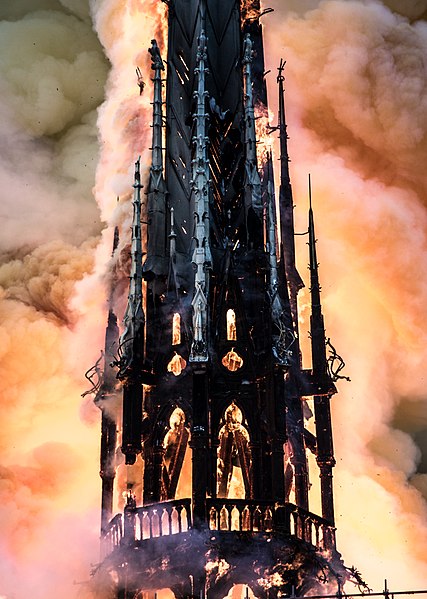
Like many people, I was riveted to social media last week, following news of the massive fire at Notre Dame de Paris. When so many other old alliances and certainties are crumbling, it felt like an apocalyptic sign of the times to watch one of the world’s most famous buildings engulfed in flames. (If I were a Christian, I’d have to seriously wonder what message God was sending by burning it down just a few days before Easter.)
Fortunately, when the fire was extinguished, the damage turned out not to be as bad as many feared. The wooden roof burned and caved in, the spire collapsed, but the stone facade and the interior of the cathedral were mostly unscathed. Even the stained glass windows survived. This was in contrast to comments I read during the fire which pessimistically suggested that without the outward pressure of the roof to balance the inward pressure of the flying buttresses, Notre Dame’s walls might collapse completely.
And I’m glad the damage wasn’t worse. I’m an atheist, but I admit that I love great cathedrals and other monumental architecture. There aren’t too many buildings that exist just to be beautiful, and though I don’t share the beliefs of the builders, I can share in the sense of awe and wonder they sought to inspire.
It’s also worth preserving as a part of the rich tapestry of human culture. Because Notre Dame has stood for 800 years, some people might have mistakenly come to believe that it would endure forever. But mere age doesn’t confer any special protection. Every generation has to choose anew whether to preserve our heritage or whether to consign it to oblivion. Landmarks like this one still exist only because every previous generation made the choice to preserve them. It would be a tragedy if our generation was the one to snap the thread.
Of course, the admiration we feel for huge cathedrals is orthogonal to our feelings for the institutions that built them. All ethical people ought to feel anger and disgust at the Roman Catholic church for a variety of good reasons. The anti-LGBT bigotry, the systemic oppression of women, the massive conspiracy to cover up for pedophiles… the list of charges goes on and on.
It’s also not unfair to point out that many of those gorgeous buildings were built with the proceeds of slave labor and colonialism. The churches aren’t uniquely guilty in this regard – the White House was also built by enslaved people, to name just one example – but it’s a reminder that they aren’t the morally flawless or infallible institutions they claim to be. Religion bears its share of culpability in all the crimes and misdeeds that stain human history.
However, the cathedrals themselves aren’t to blame for how they were made. If we tore them down tomorrow, it would do nothing to abolish the dogmatic beliefs that have caused such harm. The only way to do that is to change the contents of human minds. In a world where religion had become a thing of the past, I like to think that buildings like these could remain: not as focal points of faith, but transformed into living museums or secular spaces for meditative peace and reflection, open to all.
Just as the composer David Randolph said that there’s no such thing as religious music, because you can always pair an existing composition with different lyrics to give it any message you want, it’s equally true that there’s no such thing as religious architecture. I choose to view Notre Dame as similar to the Parthenon, the Pyramids or the lost Buddhas of Bamiyan: monumental artworks that testify to the crafters’ skill and to the creativity of the human mind, which has populated the world with wildly diverse mythologies. I don’t believe any should be taken literally, but they’re worth preserving as artifacts of the ways human beings have seen the world.
Image credit: LEVRIER Guillaume via Wikimedia Commons, released under CC BY-SA 4.0 license